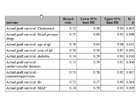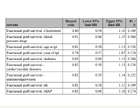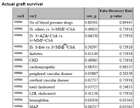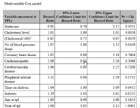F. Wiesbauer(1)*, G. Heinze(2)*, C. Mitterbauer(3), F. Harnoncourt(4), WH. Hörl(3), R. Oberbauer(3,4,5)
1- Department of Cardiology, Medical University of Vienna, Austria
2- Core Unit of Medical Statistics and Informatics, Medical University of Vienna, Austria
3- Department of Nephrology, Medical University of Vienna, Austria
4- Department of Nephrology, KH Elisabethinen, Linz, Austria
5- Austrian Dialysis and Transplant Registry, Wels, Austria
* Both authors contributed equally to the paper

Characteristics of all 1,829 patients with graft survival of at least 90 days
View PDF
Hazard function (risk for graft loss or death per year)
View PDF
Complete Case Only analysis
View PDF
Cardiovascular death outcome
Among the 2041 patients, 223 died with confirmed cardiovascular causes. 35 of these 223 deaths occurred before day 90. Extended Kaplan-Meier plot stratified for (timedependent) statin

Analysis of sensitivity of multiple imputation approach (comparison of results from multiple imputation after randomly deleting data and non-randomly deleting data)
View PDF

Analysis including events between days 0 and 90
Kaplan-Meier analysis
b actual graft survival
View PDF
Analysis including events between days 0 and 90
Kaplan-Meier analysis
c functional graft survival
View PDF



MSM analysis without statin users at baseline
View PDF
Clinical expertise models (HLA mismatches, CIT, Induction therapy, donor age forced into model)
View PDF
Interaction analysis (HR of statin use in subgroups which were close to significant)
a Patient survival
View PDF
Interaction analysis (HR of statin use in subgroups which were close to significant)
b actual graft survival
View PDF
Interaction analysis (HR of statin use in subgroups which were close to significant)
c functional graft survival
View PDF






Analysis of time to (biopsy confirmed) acute rejection
Results from Kaplan-Meier analysis and Cox regression. Dependent variable: BCAR up to one year after transplantation.

Multivariable Cox’s proportional hazards model assessing the confounder-adjusted association of statin treatment on actual graft survival (graft failure and death with functioning graft counted as endpoints)
View PDF
Kaplan-Meier curves of actual graft survival
View PDF
Multivariable Cox analysis assessing the effect of statin treatment on patient survival and functional graft survival.
View PDF
Onset of statin treatment after transplantation.
View PDF
